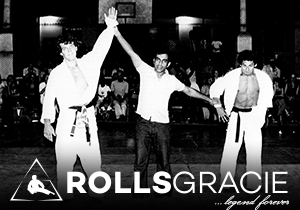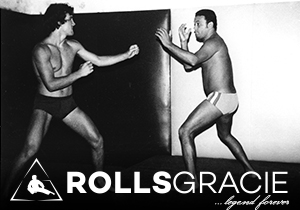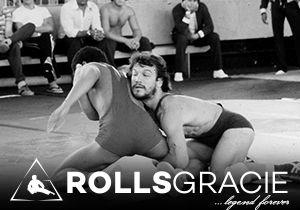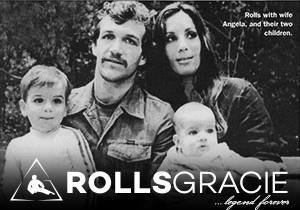The Gracie Family Legend
BY LUCA ATALLA
STRUCK DOWN AT THE HEIGHT OF HIS POWER, POPULARITY, AND INFLUENCE, ROLLS GRACIE IS CONSIDERED JIU-JITSU'S GREATEST TECHNICAL INNOVATOR, AND ALSO ITS MOST TRAGIC STORY…
On quiet nights, when the sun has dipped below the horizon and a cool breeze blows off the ocean, Brazilian jiu-jitsu masters, in a quiet voice, will gather the young students together and tell them the story of a skinny kid from Rio, with blue eyes and a quick laugh, who became a champion three decades earlier and changed a sport forever. Defending the honor of jiu-jitsu against all-comers, in all types of combat, Rolls Gracie became the hero of an entire generation who, to this day, still mourn him. To those who don't know the story, listen, learn, and take to heart the brief story of Rolls Gracie — brief because of a tragic accident, at the age of 31, that stole him away from those he touched so deeply.
Back in the 1960s, in Rio de Janeiro, a television show called Heroes of the Ring, featuring vale tudo, or no-holds-barred fighting, was banned by the government for excessive violence. The show, which highlighted the Gracie family, caused a huge negative impact on Brazilian jiu-jitsu when it was cancelled. With the show gone, the Rio media had no reason to write stories about Carlos, Helio, Carlson, and the other Gracie family members. At the same time, judo became an Olympic sport and drew many students away from jiu-jitsu. In addition, karate and kung-fu, popularized by American movies, also drew many students away. All of a sudden jiu-jitsu, which had been made so famous by the four Gracie brothers, was no longer on everyone's mind.
Jiu-jitsu needed a champion with great technique, charisma, and leadership to touch and influence the younger generation of martial artists. In Rolls Gracie, jiu-jitsu found just such a leader. The boy with the strange name, raised at 14 Bolivar St., Copacabana, Rio de Janeiro, close to the Roxy Theatre, made a conscious effort to become the banner-carrier of his era. He introduced physical education to his training program along with strikes and techniques from other martial arts. He promoted jiu-jitsu competitions but yet appealed to the mainstream youth by participating in surfing and hang-gliding. He became the leader of hundreds of young people in the south side of Rio.
Not content to take what he was told a face value, he traveled the world looking for wisdom, sharing his style, and competing against fighters of various styles on their own turf. Wherever Rolls went, he impressed everybody with his versatility, quickness, and power, Weighing only 150 pounds, he performed powerful jumps, kicks, and punches never before done by a jiu-jitsu fighter.
The son of Carlos, the oldest of the original four famous Gracie brothers, Rolls was actually raised by the youngest brother, Helio. Fittingly, Rolls was the balance point of the Gracie family — a bridge between the old and the new. But at the peak of his power, fame, and popularity, a terrible hang-gliding accident in Visconde de Maua, a small town close to Rio, took him from jiu-jitsu just as quickly as Rolls himself took out an opponent in one of his impressive fights. With his passing, the champion left behind a generation of spiritual orphans.
Championship Roots
Rolls' father, Carlos, died in 1994 at age of 92. Throughout his life, Carlos was convinced that sex had only one purpose: procreation. In 1950, he was angered when his second wife, Geny, refused to have another child. Stubborn as he was, Carlos looked for another woman to bear his 15th descendent. He eventually met Claudia, who bore him Rolls. When Geny declared that the innocent child was not welcome in her home. Helio immediately stepped in and graciously took custody of Rolls when he was only four months old. Half-a-year later, Helio's wife gave birth to his first son, Rorion. Relson came soon after and, a few years later, Rickson. The four were raised together. According to Helio, Rolls was a very hyper child but had a great heart. He never stopped for a minute and was involved in some kind of activity. At the age of 11, Rolls used to go to the Gracie Gym everyday after school to help. He was still living with his uncle Helio, but had frequent contact with his father, Carlos. Besides the weekends spent in Teresopolis, the family home, Carlos also saw his son two or three times a week when he came to the city to bring the practice kimonos to the gym from the laundry business he ran out of his home.
"Rolls was very funny kid," remembers Pimpo, a grade school friend. "A diplomat used to live in his building and his driver use to wait for him every day in a big white car. Rolls would wait for the car to be freshly washed and then throw papaya on it all the way from the 7th floor, making the vehicle totally dirty. It was funny to us but I don't think the driver or the diplomat much liked it."
Even as a child, Rolls was very strict about following the Gracie diet. "I don't recall ever seeing Rolls miss even one meal," says Pimpo. "The quantity of papaya he would eat for a meal was very impressive — while we would only have it for dessert. I guess that's where he got so much ammunition to hit the diplomat’s car.
At the age of 12, Rolls started to travel extensively — a rare occurrence in those days. His mother, Claudia, who worked for Lufthansa airlines and lived in Manhattan Island in New York, got him free airline tickets to visit her. "After a few trips to the United States, Rolls was speaking better English than me," explains Claudia. "Because he learned English very young, he didn't have any accent from here, he traveled all over the U.S." Before he turned 18, Rolls took an extended trip to Europe, where he visited the best museums, learned Italian, and gained an appreciation of history and the fine arts. Rolls was already developing the open-minded attitude that would lead him to revolutionize jiu-jitsu and become its greatest champion.
The Golden Era
But it was a defeat that would convince Rolls to take his training more seriously and take him to the next level. One day, a strong man named Cicero, who trained at a competing gym, showed up at the Gracie Gym and challenged Rolls. Everyone there thought that Rolls was the absolute best, but Cicero did surprisingly well. Pushing Rolls to the absolute limit, Cicero, with his superior strength, was able to stalemate him. "Neither of them was able to gain a superior position, but Rolls didn't win like expected," Reyson recalls. Brother Carlson agrees. "If there were points given in the match, instead of just submission only, Rolls would have lost."
When Reyson suggested that Rolls needed to train his body, the open-minded Rolls agreed. He also started visiting different schools to better improve his technique. took him to practice with Osvaldo Alves," Reyson says, "a Shunji Hinata student. Osvaldo had very good technique and had lived a few years in Japan. Rolls was obsessed and immediately started to improve. Within a year or two, he was beating everybody with no effort at all." Rolls was soon to test him-self again, in the flame of competition.
In the beginning of the 1970s, Sergio Iris, Carlson's top student, known as Serginho de Niteroi, was a phenomenon who had beaten Carley Gracie. Rolls decided that he would challenge this unbeatable fighter. "It was at that time that Rolls really started pushing his practice," remembers Osvaldo Gracie. He worked out everyday. He would run for miles, then do wind sprints. He also lifted weights, jogged on the sand and up hills, did gymnastics, and had a long training sequence of pushups and situps. When the day came for them to meet and practice together, Rolls was in unbelievable shape. On that Saturday, at Carlson's gym, Rolls triumphed over Serginho. He was the absolute family champion "
Always wanting to challenge himself, Rolls went to different gyms to practice. Carlson's gym was his favorite, though, in part because of the deep admiration Rolls had for Carlson, and partly because Carlson always had something new or improved to teach him. "He was very picky about not wanting to fall behind in the newest techniques," says Carlson. 'So when I would teach him something he didn't know, he would repeat it until he learned it completely."
Wanting to popularize jiu-jitsu among the general public, Rolls started to promote sport competitions, which at the time happened only every two or three years. At the age of 22, practicing what he preached, Rolls won the first Guanabara State Championship. "I was stronger but he won anyway", remembers Mauricio Robbe, a Pedro Hemeterio black belt. "His technique and quickness were unstoppable. I moved from Sao Paulo to Rio de Janeiro just to practice with him."
On His Own
In 1974, in a testament to the high esteem Rolls held his older brother Carlson, he stopped teaching at the Cidade Gym with Helio, and started dividing space with Carlson, in Copacabana. This marked the beginning of an era and was where Rolls put together his first competition team. It consisted of Fabio Macieira, Paulo Conde, Talarico, Nissinho Azulay, Carlinhos(Gracie Jr.), Ricardo Azoury, Marcio Macarrao, Maurição Gomes (Roger Gracie’s father), and Romero Jacare (Alliance founder). Eventually Crolin and Rilion Gracie would join the team as would Alvaro Romano, Fabio Santos, Rodrigo, Carlinhos Soneca, and Renan Pitangui.
"He was the perfect teacher," recalls Rilion. He always said the right words at the right time. One time at a competition, I had already won six juvenile matches and wanted to enter the adult tournament but I was very tired. So I sat in the corner and complained, 'I'm dead! I want to go on but I'm too tired.' Rolls came up and placed his arm around my shoulders and said, Victory without sacrifice has no meaning.' That woke me up and I entered and ended up winning all my fights."
Rolls was continually bringing new innovations and training methods to Brazil. He brought the first video cameras to Brazil and recorded all his practices and used the tapes to make corrections to his technique. He also invented the now-common interval practice, where two lines of students face each other and switch places from time to time. The method came about because of the necessity of making the Saturday practices shorter, so everyone could go out at night.
An example of his lasting influence is that two of the major jiu-jitsu organizations today are headed by former members of his first competition team — the Alliance, by Romero Jacare, and Gracie Barra, formed by Carlos Gracie Jr. "It was Rolls' example that motivated me to found the federation," Carlos Jr. says. "When Rolls died, I stopped competing for a long time. Now, I try to motivate my students to compete as much as they can — just like Rolls did."
The Driving Force
Competition was the driving force behind Rolls life. "I was just a boy when somebody showed up at the school saying that there was a karate competition that weekend," remembers Rolls cousin Royler. "And Rolls instantly answered. Put our names in it.' I didn't understand a thing that was going on, but that's how Rolls was, he would compete in anything." After his fight with Cicero, Rolls won every fight, be it in practice or in tournaments. Nobody remembers seeing him tired or with his guard down. He was always looking for sponsors and never let a long period of time go by without winning a championship. He loved to fight and competed in free-fighting, Greco-Roman wrestling, and sambo. In 1976, Rorion and Helio went on a TV show to demonstrate the art of jiu-jitsu. A few days later a karate teacher also went on. When the host of the show asked how karate would do against jiu-jitsu, the karate master said that they could beat jiu-jitsu fighters very easily. A challenge was made when Rolls heard of this and, when it happened, every jiu-jitsu fighter won. In the final fight between the two masters, shown on the tape Gracie Jiu-Jitsu in Action, Rolls won easily.
As Rolls' fame grew, no opponents would come to jiu-jitsu competitions to fight him. When Rolls was entered, only one or two men would show up to give it a try. Rolls eventually started visiting the United States in search of matches. In one of his trips to the USA, a friend from New York introduced him to Bob Anderson, a five-time national wrestling champion who weighed 220 pounds. Anderson and Rolls became friends and Anderson went to Brazil for two months to train and teach wrestling classes at Rolls' academy, while staying at Rolls' house.
Even though Anderson never practiced with Rolls, he used to joke about Rolls, saying: "Only in Rio could a skinny guy like you be a wrestling champion!" Angela and Rolls' students didn't like Anderson's joke very much, but it didn't bother Rolls at all. The day before Anderson was supposed to leave, Rolls invited him to practice. Anderson, to his disbelief, could do nothing against the much-smaller Rolls. Getting upset, he took his gi off and threw it on the floor in disgust. "I can't fight with this thing on. Let's wrestle my way." Rolls agreed and the two went at it again. After numerous attempts to take Rolls down and submit him, the exhausted Anderson finally gave up. From then on he treated "the skinny little guy from Rio" with a new-found respect.
Two months later, Anderson invited Rolls to visit him in the U.S. and compete in the Sambo Pan American Championships in San Diego. Rolls accepted, of course, because it combined the two things that he liked most in life: competition and travel. He learned the sambo rules over the phone and departed to California with Angela, now pregnant with their second child, Igor. When they arrived, the FILA (International Federation of Amateur Fights) committee surprised them at the event they had been invited to watch him fight in the tournament. Even though sambo fighters could not use any kind of strangulation, sambo and jiu-jitsu, were very similar, and Rolls easily beat the top sambo players at the event. The committee asked him to stay one more day and fight again. Rolls accepted with pleasure.
The next night, the committee brought in eight fighters from different weight categories and styles. Rolls dropped them to the floor with no mercy and with almost no rest intervals between the matches. The committee was so impressed that they invited him to move to the USA and teach at the American Fighting Institute, with a base salary of $5,000 per month — a fortune at the time. According to Bob, everyone was impressed with Rolls' versatility and creativity. Rolls was able to counter any attack, be it striking or grappling, from any position. Rolls went back to Brazil, ready to accept the offer. When he told his uncle Helio the news, Helio asked him not to leave because they needed the presence of the Brazilian jiu-jitsu champion in South America, to support the sport and give inspiration to its followers. As Angela recalls, "Rolls immediately agreed and I was very frustrated at the time because it was a big opportunity to our lives."
The Last Flight
It had been six months since he had promised his wife that he was not going to fly anymore. But on a weekend he went to Visconde de Maua with a friend named Luiz Fernando, and their wives and kids. According to friend Ricardo Azoury, even though Rolls was not prepared to hang glide, and even though he had fallen twice during practice that day, he threw himself into the deadly jump without a second thought.
"We stayed in Maringa," Fernando recalls. "I was in the lobby on Sunday when a friend called Ze Joao came in to say he was leaving and needed to use the phone. Rolls walked with Ze and noticed a hang-glider on it which, by coincidence, he had once owned. Rolls immediately started making plans for a flight. Angela, his wife, was furious, but Rolls didn't listen and made plans to fly that afternoon. When we were going to the ramp we saw Ze Joao coming back. He said they couldn't fly because there were no wind. But Rolls said to him, 'Oh, come on, Champion, let's go for at least one flight!' Ze refused but agreed to let Rolls borrow his hang-glider. Rolls set it up in very deep silence. He finally looked at me and said his final words: 'Hey, Champ, help me lift the hang-glider so I can adjust the sarcophagus.' Angela said, 'Have a good flight, my love.' Their children, Rollesinho and Fernandinho waved at him from where they were playing and yelled out, `Have a good flight, Daddy! With that, he pushed off.
His wings lifted just a little bit but, as Ze had warned, there was no wind. He veered to the right, the spiraled to the left and crashed to the ground... Everybody was in a panic and I ran down hill to where he had fallen. When I got there, his blue eyes were wide open and his arms were straight pointing to the top of the glider like he was struggling to keep it up. He looked fine, but was already dead when I reached him." The day was June 6, 1982.
The intensity with which Rolls Gracie lived was, ultimately, what contributed to his death. The amazing thing about him, many say, was how he managed to make time to do so many things at the same time. "He made sure he was in bed by 8:00 pm," says Azoury. "Every Friday he would say, 'I don't know if I'm going to Buzios, Teresopolis, or New York!' And the thing is, he had those options! In such a small amount of years, he taught, fought, practiced, surfed, flew, traveled. exercised, rode horses, dedicated time to his family and friends, studied, learned. improved, and turned around the way to see and practice jiu-jitsu. He didn't become a legend for no reason. He earned his reputation and he deserved it!"
The Memories
""Rolls was so brave that if you didn't know him you'd swear he was trying to commit suicide, says Helio Gracie. "Maybe that led him to such a premature death. He drove cars a very high speeds, and twice flipped the car he was driving. He was an excellent surfer and there was no kind of ocean that he wouldn't go in. I wish he had been just a little more careful."
Today, Rolls is considered a bridge between the old, plodding, methodical style of jiu-jitsu and the new aggressive system that is so popular. "Rolls adapted movements from many other martial arts and integrated them into jiu-jitsu," says brother Robson. "There were times when all the Gracie family members were practicing together and nobody, not even the seniors, would say or contest anything Rolls did. He was always teaching variations from unknown positions, many of which are still used today.”
Reversals, offensive attacks, and lighting adjustments to his opponent's positions were Rolls' trademarks, and his technical innovations in those areas stand as a testament to his genius and versatility.
Luca Atalla







